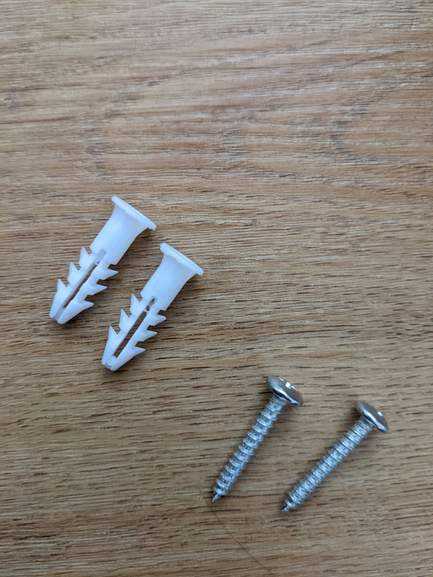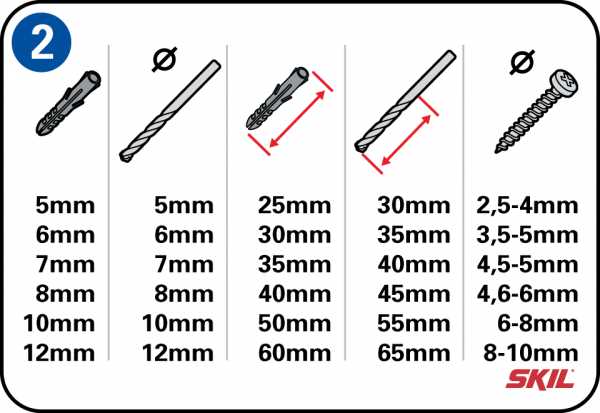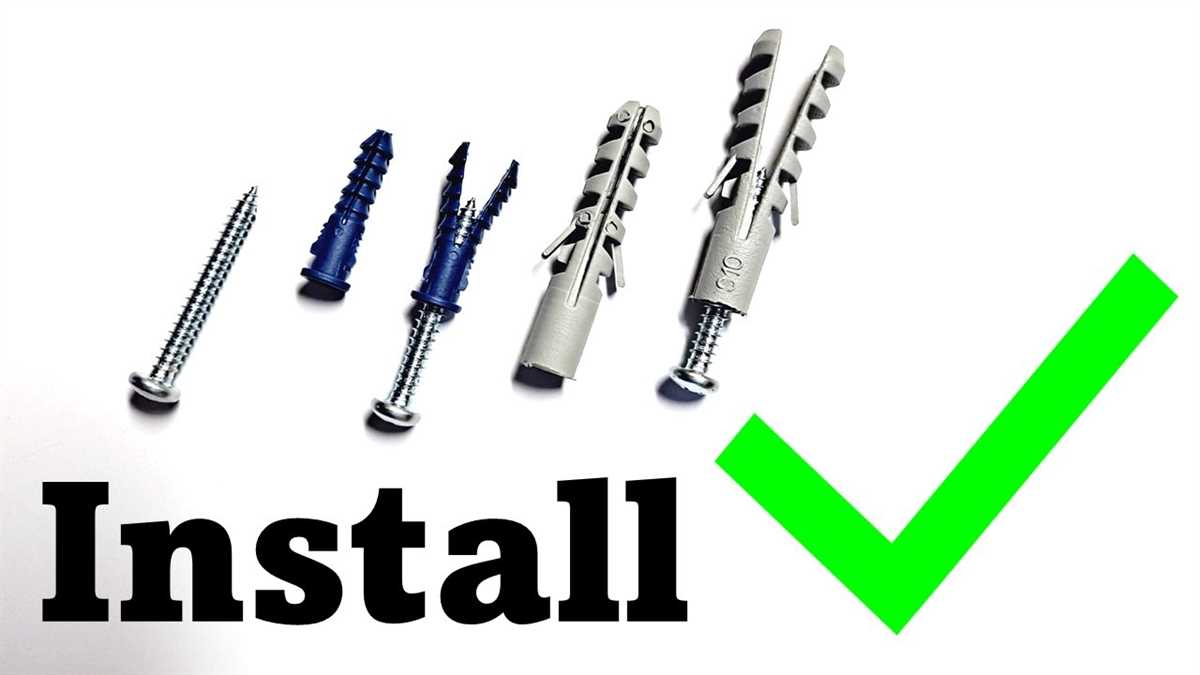Choosing the Right Drill Bit Size for Wall Plugs

When it comes to hanging shelves, pictures, or other items on the walls, using wall plugs is a common and effective solution. Wall plugs (also known as anchors or rawl plugs) provide extra support and stability by gripping the walls with their expanding sleeves. However, to ensure that the wall plugs are securely in place, it is crucial to use the right drill bit size when creating the holes for the plugs.
The drill bit size needed for wall plugs depends on the diameter of the plug itself. Most wall plugs come with a recommended drill bit size in their packaging, which should be followed for optimal performance. If the recommended drill bit size is not available, there are some general guidelines to consider.
The drill bit size should be slightly smaller than the diameter of the wall plug to allow for a snug fit. A drill bit that is too large can result in a loose fit, while a bit that is too small may cause the plug to crack or be difficult to insert. It is always better to start with a smaller drill size and gradually increase if necessary, rather than using a drill bit that is too large from the beginning.
Importance of Choosing the Right Drill Bit Size
When it comes to drilling holes for wall plugs, choosing the right drill bit size is crucial. A proper fit between the wall plug and the drill hole is essential for ensuring a secure and lasting anchor. Using the wrong size drill bit can result in a loose connection between the wall plug and the wall, compromising the stability and safety of any fixtures or objects being supported.
Here are a few reasons why choosing the right drill bit size is important:
1. Stability and Safety
Using the correct drill bit size ensures a snug fit between the wall plug and the drill hole. This tight connection provides stability, preventing any wobbling or shifting of the object being anchored to the wall. It also enhances safety by reducing the risk of the fixture or object falling due to a loose connection.
2. Proper Load Distribution
By using the right drill bit size, the load being applied to the wall is distributed evenly across the wall plug. This helps prevent any stress concentrations on a particular area of the wall plug, which could potentially cause it to fail. Proper load distribution is essential for maintaining the integrity and strength of the wall plug and its anchor.
3. Ease of Installation

Choosing the correct drill bit size makes the installation process much easier and more efficient. With the right size drill bit, the drill will be able to create the hole smoothly and effortlessly, without causing any unnecessary damage to the wall. This not only saves time and effort but also reduces the chances of the hole being too large or irregularly shaped, minimizing the need for additional wall plug adjustments or repairs.
4. Longevity of the Anchor
Using the proper drill bit size ensures a secure and tight connection between the wall plug and the wall. This longevity of the anchor is essential for maintaining the stability of the fixture or object being supported over time. A loose or improperly fitted anchor can gradually lead to increased movement and stress on the wall plug, causing it to weaken and eventually fail. By choosing the correct drill bit size, you can ensure the longevity and durability of the anchor.
In conclusion, choosing the right drill bit size is paramount when drilling holes for wall plugs. It not only provides stability and safety but also ensures proper load distribution, eases the installation process, and promotes the longevity of the anchor. By taking the time to select the appropriate drill bit size, you can ensure a secure and lasting connection between the wall plug and the wall, enhancing the overall effectiveness and reliability of your fixtures or objects.
Factors to Consider when Choosing a Drill Bit Size

Choosing the right drill bit size is crucial for a successful drilling project. Here are some factors you should consider when selecting a drill bit size:
- Material: Different materials require different drill bit sizes. For example, drilling into concrete or brick may require a larger drill bit size compared to drilling into wood or metal.
- Application: The type of application you are using the drill bit for will also affect the size you choose. For instance, if you are drilling pilot holes for screws, you will need a bit that matches the size of the screw.
- Wall plug size: If you are using wall plugs for mounting purposes, it is important to choose a drill bit size that matches the size of the wall plug. This will ensure a snug fit and secure hold.
- Depth: Consider the depth of the hole you need to drill. If you are drilling a shallow hole, a smaller drill bit size may be sufficient. However, for deeper holes, a larger bit size may be required to achieve the desired depth.
- Accuracy: If you require precise drilling, it is important to choose a drill bit size that matches the size of the hole you need. Using a bit that is too large or too small can result in an inaccurate hole.
It is always recommended to consult the manufacturer’s guidelines or seek professional advice when choosing a drill bit size. Taking into account the factors mentioned above will help you select the right size for your specific drilling needs.
Understanding Wall Plug Sizes
When it comes to securing items to your walls, such as shelves, picture frames, or mirrors, using wall plugs is essential. These small plastic or metal devices create a secure anchor point for screws or nails, ensuring that your objects remain safely mounted. However, in order for a wall plug to be effective, it must fit snugly in the hole drilled into the wall. To achieve this, it is important to understand wall plug sizes and choose the appropriate drill bit size.
Types of Wall Plugs
There are several types of wall plugs available, and each is designed for specific applications and materials. The most common types of wall plugs include:
- Standard Wall Plugs: These are the most commonly used wall plugs and are suitable for a wide range of materials, such as concrete, brick, and drywall.
- Hollow Wall Anchors: These wall plugs are designed for use in hollow or cavity walls, such as drywall or plasterboard. They expand behind the wall surface to provide a secure anchor point.
- Metal Wall Plugs: Made from metal, these wall plugs are durable and suitable for heavy-duty applications.
Wall Plug Sizes
Wall plugs come in various sizes, which are determined by their diameter and length. The size of the wall plug you choose should match the size of the screw or nail you plan to use. Common wall plug sizes range from 5mm to 13mm in diameter, with lengths ranging from 25mm to 50mm.
| Diameter (mm) | Length (mm) | Recommended Drill Bit Size (mm) |
|---|---|---|
| 5 | 25 | 5 |
| 6 | 30 | 6 |
| 8 | 40 | 8 |
| 10 | 50 | 10 |
Choosing the Right Drill Bit Size
Choosing the right drill bit size is crucial for properly installing wall plugs. The drill bit should be slightly smaller than the diameter of the wall plug, allowing for a tight fit. This ensures that the wall plug expands properly and creates a secure anchor point.
- Select the appropriate wall plug size based on the weight and material of the item you are installing.
- Refer to the recommended drill bit size chart to determine the correct drill bit size.
- Insert the selected drill bit into the drill and tighten it securely.
- Mark the desired location on the wall for the wall plug and drill a hole using the selected drill bit.
- Remove any particles or debris from the hole.
- Insert the wall plug into the hole and tap it gently with a hammer until it is flush with the wall surface.
- Insert the screw or nail into the wall plug and tighten it until secure.
By understanding wall plug sizes and choosing the appropriate drill bit size, you can ensure that your items are securely mounted to the wall, providing peace of mind and preventing accidents or damage.
Matching Drill Bit Size with Wall Plug Size
When it comes to drilling holes for wall plugs, it’s important to use the right drill bit size. Choosing the correct size will ensure a proper fit for the wall plug and provide a strong and secure anchor. Here are some guidelines to help you match the drill bit size with the wall plug size:

1. Consider the Wall Plug Size
The first step is to determine the size of the wall plug you’ll be using. Wall plugs come in various sizes, typically labeled by their diameter in millimeters or inches. Common sizes include 6mm, 8mm, 10mm, and 12mm. Check the packaging or product specifications to find out the size of the wall plug.
2. Choose a Drill Bit Size
Once you know the wall plug size, you can choose a drill bit that matches it. Generally, the drill bit should be slightly smaller than the wall plug to ensure a snug fit. For example, if you have a 6mm wall plug, you’ll want to use a 5mm drill bit. This will allow the wall plug to anchor firmly in the hole without being too loose or too tight.
3. Use a Wall Plug Size Chart
If you’re uncertain about the suitable drill bit size for a particular wall plug size, you can refer to a wall plug size chart. These charts provide recommendations for the corresponding drill bit sizes based on the wall plug diameter. They can be found online or at hardware stores and can serve as a handy reference guide.
4. Test the Fit
Before drilling into the wall, it’s a good idea to test the fit of the wall plug in a small pilot hole. This will help ensure that the wall plug and the drill bit are a proper match. If the wall plug fits too loosely or too tightly, you may need to choose a different drill bit size.
5. Consider Wall Material
When selecting a drill bit size, it’s important to consider the material of the wall you’ll be drilling into. Different wall materials may require different drill bit sizes. For example, drilling into plaster, drywall, or wood may require a smaller drill bit size compared to drilling into concrete or masonry. Refer to the manufacturer’s recommendations or consult a professional if you’re unsure.

By matching the drill bit size with the wall plug size, you’ll be able to create secure and reliable anchor points for your wall fixtures, ensuring they stay in place and provide the necessary support.
Common Drill Bit Sizes for Wall Plugs
When it comes to choosing the right drill bit size for wall plugs, there are a few common options that you can consider. The size of the drill bit you choose will depend on the size of the wall plug you are using, as well as the type of material you are drilling into.
1. 4mm Drill Bit
The 4mm drill bit is commonly used for wall plugs that have a diameter of 4mm. This drill bit size is suitable for lightweight tasks and is commonly used for drilling holes into plasterboard or hollow walls.
2. 5mm Drill Bit
The 5mm drill bit is slightly larger than the 4mm size and is commonly used for wall plugs with a diameter of 5mm. This size is suitable for medium-weight tasks and can be used for drilling holes into materials such as drywall or wood.
3. 6mm Drill Bit
The 6mm drill bit is a versatile size that can be used for different types of wall plugs, including those with a diameter of 6mm or smaller. This size is suitable for heavy-duty tasks and can be used for drilling into materials like concrete or brick.
4. 8mm Drill Bit

The 8mm drill bit is commonly used for larger wall plugs, typically those with a diameter of 8mm or bigger. This size is suitable for heavy-duty tasks and is often used for drilling into materials like concrete or stone.
Note that these are just a few common drill bit sizes for wall plugs, and there may be other sizes available depending on your specific needs. It’s important to choose the right drill bit size to ensure a secure and snug fit for your wall plugs.
Tips for Successful Drill Bit Selection
- Consider the material: Different drill bits are designed for different materials. Before selecting a drill bit, consider the material you will be drilling into. For example, wood, metal, and concrete each require specific types of drill bits.
- Check the size: Ensure that the drill bit is the correct size for the job. Using a drill bit that is too small or too large can result in poor performance or damage to the material.
- Choose the right shank type: Drill bits come in different shank types, including straight shank and hex shank. The shank type should match the type of drill you will be using.
- Consider the drilling depth: Some drill bits are designed specifically for certain drilling depths. If you need to create a hole of a specific depth, choose a drill bit that is suitable for that depth.
- Check the drill bit coating: Some drill bits have coatings that help reduce friction and increase durability. If you will be drilling through a hard material, such as metal, consider using a coated drill bit for better performance.
- Invest in a quality drill bit set: Instead of buying individual drill bits, consider investing in a quality drill bit set. This will give you a range of sizes and types to choose from, ensuring that you always have the right drill bit for the job.
- Consult the manufacturer’s recommendations: Always refer to the manufacturer’s recommendations for the specific drill you are using. They may have specific guidelines for drill bit selection based on their product’s capabilities and limitations.
FAQ:
What is the importance of choosing the right drill bit size for wall plugs?
Choosing the right drill bit size for wall plugs is important because it ensures a proper fit between the plug and the hole, which determines the overall stability and strength of the fixture. Using the wrong size can result in loose or weak attachments.
How do I determine the right drill bit size for a specific wall plug?
To determine the right drill bit size for a specific wall plug, you need to check the diameter of the plug or the size indicated on the packaging. Once you have the diameter, choose a drill bit that matches it exactly to achieve a snug fit.
What if I don’t have a drill bit that matches the exact size of my wall plug?
If you don’t have a drill bit that matches the exact size of your wall plug, it’s better to choose a slightly smaller size drill bit and gradually enlarge the hole until the plug fits securely. This can be done by using a larger drill bit or by twisting the smaller drill bit while drilling to widen the hole.
What are the consequences of using a drill bit that is too small for a wall plug?
Using a drill bit that is too small for a wall plug can result in a loose fit, which can lead to instability and weak attachment of the fixture. The plug may not hold securely in the hole and can easily come out or cause damage to the surrounding area.
Is it possible to use a drill bit that is slightly larger than the wall plug?
While it is possible to use a drill bit that is slightly larger than the wall plug, it is generally not recommended. The larger hole can compromise the stability of the fixture and may require additional measures, such as using larger wall plugs or adding extra adhesive, to ensure a secure attachment.
Video:









